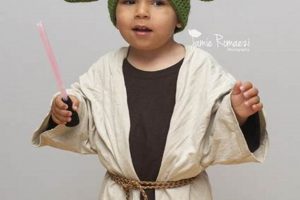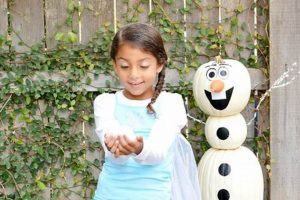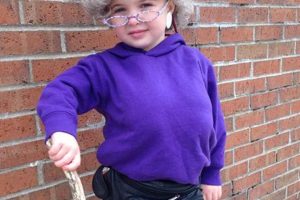Creating a villainous monarch ensemble at home involves constructing a garment and accessories that evoke a sense of dark majesty. This often includes repurposing existing clothing items, crafting new components from affordable materials, and employing makeup techniques to achieve a menacing yet elegant aesthetic. For example, a long black dress can be enhanced with a high collar made from stiffened fabric, paired with a crown crafted from craft foam and faux jewels.
The practice of fabricating a personalized antagonist appearance offers several advantages. It provides a cost-effective alternative to purchasing pre-made attire. Furthermore, it allows for a high degree of customization, ensuring a unique and individualized representation. Historically, theatrical and celebratory clothing was commonly produced in domestic settings; this activity represents a continuation of that tradition, blending resourcefulness with creative expression. This also gives rise to confidence, joy, creativity, uniqueness and personalized imagination.
Subsequent sections will explore specific techniques for constructing various elements of such a costume, including dress modification, headwear design, and makeup application, while offering tips for achieving a polished and convincing final result. Detailed instructions and resource suggestions will assist in the successful completion of this endeavor.
Tips for a Superior Antagonist Garb Creation
The subsequent advice aims to facilitate the effective and aesthetically compelling construction of a villainous queen’s attire. Attention to detail and resourcefulness are paramount.
Tip 1: Fabric Selection is Critical. Opt for materials with a substantial drape and weight, such as velvet, brocade, or heavy satin, to convey an impression of opulence and power. Avoid flimsy or overly synthetic fabrics that can detract from the overall effect.
Tip 2: Silhouette Enhancements. Consider incorporating elements that accentuate a commanding presence. A structured bodice, padded shoulders, or a voluminous skirt can contribute to a more imposing figure.
Tip 3: Crown Construction: Prioritize Stability. When crafting the crown, use a sturdy base material, such as craft foam or heavy cardstock, to ensure it maintains its shape. Secure embellishments, such as faux jewels and metallic accents, with strong adhesives.
Tip 4: Makeup Application: Emphasize Definition. Focus on creating a dramatic contrast in the makeup. Bold eyeliner, dark eyeshadow, and a defined lip line will accentuate the character’s sharp features and malevolent nature.
Tip 5: Attention to Detail: The Importance of Accessories. Incorporate accessories that reinforce the character’s persona, such as a scepter, a jeweled necklace, or a pair of long gloves. These small details can significantly enhance the overall impact.
Tip 6: Color Palette Considerations. Adhere to a color scheme that reflects the character’s malevolence. Deep reds, purples, blacks, and metallics are effective choices for conveying a sense of darkness and power.
Tip 7: Research and Inspiration. Thoroughly examine various interpretations of villainous queen characters from film, literature, and art. This research can provide valuable inspiration for designing a unique and impactful costume.
These recommendations emphasize the significance of careful planning, material selection, and execution. Attention to these elements contributes to a more convincing and memorable representation.
The concluding section will summarize the key elements discussed and offer final considerations for achieving a successful creation of antagonist-themed attire.
1. Malevolent Majesty
Malevolent Majesty, within the framework of constructing a villainous queen costume, signifies the overall aura of power, darkness, and regal authority that the attire seeks to project. It is the central objective of the DIY endeavor and dictates many design choices.
- Imposing Silhouette
An imposing silhouette contributes significantly to Malevolent Majesty. This involves employing structural elements, such as capes, high collars, or voluminous skirts, to create a visually dominant and authoritative presence. Examples include Queen Ravenna’s feathered collar in Snow White and the Huntsman, which enhances her stature and reinforces her power. In the context of crafting your own queen’s look, careful consideration of silhouette ensures the costume commands attention and instills a sense of intimidation.
- Dark Color Palette
The strategic use of a dark color palette is critical. Deep reds, blacks, purples, and metallics evoke a sense of foreboding and sophistication, aligning with the villainous character archetype. The Evil Queen from Snow White, often depicted in stark black and purple, exemplifies this principle. When selecting fabrics and accessories for a self-made ensemble, a deliberate choice of darker hues enhances the malevolent aesthetic and emphasizes the character’s sinister nature. Dark tones can also be matched to specific characters.
- Regal Embellishments
Regal embellishments are essential in conveying majesty. These include crowns, jeweled accessories, and intricate detailing that suggest wealth and power. Maleficent’s horned headdress, for example, establishes her as a formidable and otherworldly figure. When fabricating a unique queen costume, the addition of carefully chosen embellishments, whether genuine or faux, elevates the costume’s aesthetic and emphasizes the character’s royal status.
- Dominating Makeup and Expressions
Makeup and expressions play a crucial role in amplifying Malevolent Majesty. Sharp, defined features, such as dramatic eyeliner, darkened lips, and intense facial expressions, can convey a sense of coldness and cruelty. The Evil Queen’s severe makeup in Disney’s Snow White is a notable example. When applying makeup for a custom-made outfit, focus on creating a striking, severe look that reflects the character’s inner darkness and reinforces her domineering nature.
These elements silhouette, color, embellishments, and makeup work synergistically to establish Malevolent Majesty within the framework of the queen creation process. By carefully considering and integrating these facets, the costume designer can effectively embody the desired aura of power and darkness, transforming a collection of materials into a symbol of regal malevolence.
2. Repurposed Materials
The strategic utilization of repurposed materials is a foundational element in constructing a convincing antagonist queen costume. This approach prioritizes resourcefulness and sustainability while fostering creative innovation in the design proces
s. The practice necessitates a careful evaluation of existing resources to transform them into components that embody the character’s malevolent aesthetic.
- Garment Transformation
This facet entails the modification of pre-existing clothing items to align with the costume’s desired aesthetic. Examples include altering a long black dress found in a thrift store by adding a high collar crafted from repurposed cardboard or stiffened fabric scraps. This reduces reliance on purchasing new textiles and minimizes textile waste, as well as saving lots of money. Such transformations leverage the existing structure of a garment, reducing the overall construction effort, making old items, new, as well as saving money.
- Accessory Recycling
Accessory recycling involves the conversion of discarded items into components of the costume. For example, plastic bottles can be melted and reshaped into a crown or scepter base. Old jewelry can be disassembled and reconfigured to create embellishments for the costume’s bodice or headwear. This approach encourages creative problem-solving and reduces the demand for newly manufactured accessories.
- Fabric Salvaging
Fabric salvaging refers to the act of acquiring discarded textiles from various sources, such as old curtains, upholstery remnants, or fabric scraps from previous sewing projects. These salvaged fabrics can be used to construct various elements of the costume, including capes, sleeves, or decorative trim. This strategy promotes sustainability by diverting textiles from landfills and reducing the environmental impact associated with textile production.
- Hardware Adaptation
Hardware adaptation involves repurposing household items, such as wire hangers, cardboard boxes, or plastic containers, for structural components of the costume. For example, a wire hanger can be bent and shaped to create the frame for a crown, or a cardboard box can be used to construct a stiffened underskirt to add volume to the dress. This practice minimizes the need to purchase new hardware and reduces waste by finding alternative uses for discarded materials.
The effective integration of repurposed materials within the antagonist queen creation process showcases ingenuity and environmental consciousness. This method allows the creator to produce a unique and compelling costume while adhering to principles of sustainability and resource efficiency. This approach exemplifies how creative practices can intersect with environmental responsibility to achieve both aesthetic and ethical goals, and contribute to your evil plan.
3. Detailed Construction
Detailed Construction forms a critical juncture in the successful realization of an “evil queen costume diy” project. It represents the tangible manifestation of creative intent, directly influencing the overall aesthetic impact and structural integrity of the final product. The degree of precision and attention applied during this phase directly correlates with the costume’s perceived quality and authenticity.
Consider, for example, the creation of a high, structured collar, a common motif in villainous queen attire. Superficial execution, employing flimsy materials and imprecise cutting, results in a collar that lacks the desired dramatic flair and may collapse under its own weight. In contrast, a meticulous approach, utilizing interfacing to provide rigidity, precise pattern drafting, and secure stitching, yields a collar that stands erect, commanding attention and contributing significantly to the costume’s overall sense of malevolence. Similarly, the application of embellishments, such as faux jewels or metallic trim, necessitates careful placement and secure attachment. Haphazard application detracts from the costume’s perceived value, whereas thoughtful arrangement and robust fastening enhance its visual appeal and longevity.
The implementation of intricate sewing techniques, such as boning in a bodice or the creation of elaborate sleeves, further underscores the importance of Detailed Construction. The structural support provided by boning ensures a flattering and historically accurate silhouette, while complex sleeve designs add visual interest and convey a sense of regal opulence. These techniques, while demanding, are essential for achieving a level of realism and sophistication that elevates the costume beyond a mere imitation. In summation, Detailed Construction serves as the pivotal element that transforms a concept into a tangible and compelling representation of an antagonist monarch, impacting the costume’s visual appeal, structural soundness, and overall effectiveness.
4. Dramatic Makeup
The application of theatrical cosmetics is an indispensable element in completing a homemade antagonist queen ensemble. The skillful use of color, contour, and definition transforms the wearer, enhancing the costume’s overall impact and conveying the character’s inherent malevolence. Specific techniques and products contribute to this transformation.
- Contouring and Shadowing
Strategic contouring and shadowing redefine facial structure, creating a more angular and severe appearance. Dark shades applied beneath the cheekbones, along the jawline, and at the temples create depth and emphasize the bone structure. The effect simulates a more gaunt or hardened visage, characteristic of many villainous figures. For example, stage makeup frequently employs heavy contouring to create dramatic facial features for antagonists, reinforcing the character’s coldness. The successful execution of contouring is essential for achieving a powerful, intimidating effect.
- Eye Emphasis
Emphasizing the eyes with bold eyeliner, dark eyeshadow, and dramatic lashes draws attention to this focal point and conveys intensity. A winged eyeliner style, combined with a smoky eye effect, creates a piercing gaze that reinforces the character’s dominance. The use of dark, saturated colors, such as black, deep purple, or emerald green, enhances the eyes’ visual impact. This technique draws direct influence from interpretations of queens.
- Lip Definition
Defining the lips with a dark, saturated color creates a striking visual contrast and emphasizes the mouth as a point of power. Deep reds, purples, and even black lipsticks are common choices, conveying a sense of sophistication and danger. A precise lip line further enhances the effect, creating a sharp, defined shape that commands attention. When paired with intense gaze, it draws influences from many characters.
- Skin Tone Manipulation
Altering the skin tone with foundation or powder creates a canvas for the rest of the makeup application and can contribute to the overall dramatic effect. A pale, almost porcelain complexion can convey a sense of detachment or ill health, while a subtly contoured base enhances the structure of the face. The key is to create a flawless base that complements the other makeup elements and enhances the character’s overall aesthetic. These decisions draw influence from various characters.
These aspects of theatrical cosmetics represent an integral facet of DIY antagonist queen costumery. Through the skillful manipulation of color, contour, and definition, the wearer can effectively embody the character’s inherent malevolence, transforming a simpl
e garment into a potent symbol of power and darkness.
5. Commanding Presence
In the context of homemade villainous queen attire, “Commanding Presence” represents the overall effect the costume has on an audience or the wearer’s self-perception. It is the culmination of design choices, construction techniques, and performance elements that project authority, power, and control. The creation of such an effect necessitates a deliberate and strategic approach to all aspects of the costume’s design and execution.
- Posture and Bearing
The wearer’s posture and bearing are integral to projecting a commanding presence. A straight spine, squared shoulders, and deliberate movements convey confidence and authority. Training in stage presence or historical deportment can enhance the wearer’s ability to embody the character effectively. For example, actors portraying queens often undergo training in posture and gait to project an aura of power, influencing how the costume is perceived.
- Gait and Movement
The manner in which the wearer moves contributes significantly to the overall impression of authority. Slow, deliberate strides, coupled with controlled gestures, convey a sense of purpose and control. A wide stance and expansive movements can further enhance the impression of dominance. Real-world examples of leaders exhibiting controlled and deliberate movements illustrate the impact of gait on projecting authority. These techniques translate effectively to costumed portrayals, reinforcing the character’s commanding presence.
- Vocal Delivery
The wearer’s vocal delivery is another key element in projecting a commanding presence. A clear, resonant voice, coupled with deliberate pacing and enunciation, commands attention. Varying intonation and volume can be used to emphasize key points and convey emotions effectively. Consider the vocal techniques employed by stage actors portraying royalty; their ability to project authority through vocal delivery underscores the importance of this element in creating a believable and commanding character.
- Interaction with Others
The way in which the wearer interacts with others directly impacts the perception of their commanding presence. Maintaining eye contact, using direct and assertive language, and exhibiting confidence in one’s actions are all essential. A queen who issues commands with assurance and demands respect through her demeanor projects an aura of authority. The wearer’s ability to embody these qualities enhances the overall impact of the costume and reinforces the character’s commanding presence.
These elements posture, gait, vocal delivery, and interaction function collectively to establish a commanding presence. Successful integration of these elements transforms a simple assemblage of materials into a powerful representation of regal authority, influencing both the wearer’s self-perception and the audience’s interpretation of the character. This highlights the importance of considering not only the visual aspects of the costume but also the performative elements that bring the character to life, and further enhances the DIY creation.
Frequently Asked Questions
This section addresses common inquiries and clarifies potential misconceptions regarding the creation of a personalized villainous monarch ensemble. The information presented aims to provide clarity and guidance for successful completion of the project.
Question 1: What is the expected timeframe for completing a homemade villainous queen outfit?
The timeline for completion varies depending on the complexity of the design and the creator’s skill level. A basic costume utilizing repurposed materials may be completed within a week, while a more elaborate design requiring extensive sewing and embellishment may take several weeks or longer.
Question 2: Is prior sewing experience required to undertake this endeavor?
While prior sewing experience is beneficial, it is not strictly required. Simpler designs can be executed with basic hand-sewing skills or by modifying existing garments. More complex designs may necessitate intermediate-level sewing skills or the assistance of a skilled seamstress.
Question 3: What are the most cost-effective materials for creating a convincing crown?
Craft foam, heavy cardstock, and wire are cost-effective materials for crown construction. These materials can be shaped and embellished with faux jewels, metallic paint, or other decorative elements to create a visually appealing crown without incurring significant expense.
Question 4: How can a commanding presence be achieved without extensive acting experience?
A commanding presence can be cultivated through conscious effort. Focus on maintaining proper posture, practicing deliberate movements, and employing clear and assertive vocal delivery. Observing the performances of actors portraying regal or authoritative figures can provide valuable insights.
Question 5: What are the ethical considerations when repurposing materials for a costume?
When repurposing materials, it is essential to ensure that the source materials are obtained legally and ethically. Avoid using materials that have been obtained through illegal means or that may pose a health hazard. Properly cleaning and sanitizing repurposed materials is also recommended.
Question 6: How can one ensure the costume is historically accurate, if desired?
Historical accuracy requires thorough research into the specific time period and cultural context the costume is intended to represent. Consulting historical texts, paintings, and museum artifacts can provide valuable insights into appropriate garment styles, fabrics, and accessories.
In summary, effective construction involves dedication and awareness. The creator must invest time, energy, and creativity in the project.
The next section will offer concluding remarks and recommendations for achieving a successful construction.
Conclusion
The foregoing analysis has explored the multifaceted aspects of creating a villainous monarch attire. From the initial conception of malevolent majesty to the practical considerations of material selection and detailed construction, this endeavor necessitates a fusion of artistic vision and technical proficiency. Furthermore, the importance of theatrical cosmetics and the cultivation of a commanding presence have been underscored as integral components in achieving a convincing and impactful final result.
The successful execution of an evil queen costume diy represents more than the mere assembly of garments and accessories. It embodies a creative exploration of power, darkness, and artistry, transforming repurposed materials into a tangible representation of villainous authority. Future costumers should consider the points provided for high quality garment.







